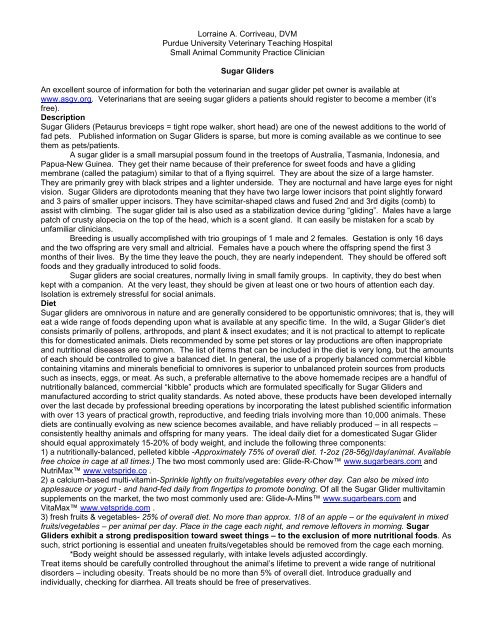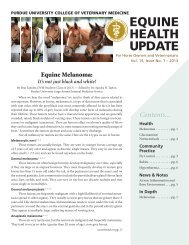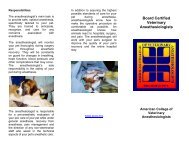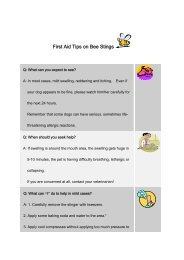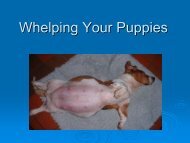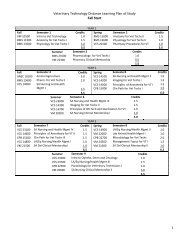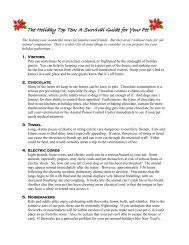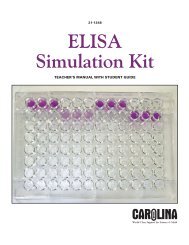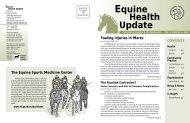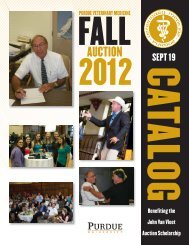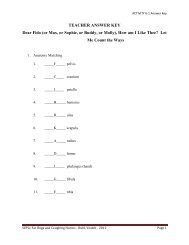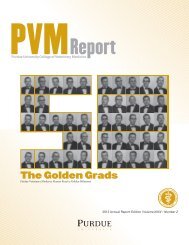Sugar Gliders - Purdue University School of Veterinary Medicine
Sugar Gliders - Purdue University School of Veterinary Medicine
Sugar Gliders - Purdue University School of Veterinary Medicine
Create successful ePaper yourself
Turn your PDF publications into a flip-book with our unique Google optimized e-Paper software.
Lorraine A. Corriveau, DVM<br />
<strong>Purdue</strong> <strong>University</strong> <strong>Veterinary</strong> Teaching Hospital<br />
Small Animal Community Practice Clinician<br />
<strong>Sugar</strong> <strong>Gliders</strong><br />
An excellent source <strong>of</strong> information for both the veterinarian and sugar glider pet owner is available at<br />
www.asgv.org. Veterinarians that are seeing sugar gliders a patients should register to become a member (it’s<br />
free).<br />
Description<br />
<strong>Sugar</strong> <strong>Gliders</strong> (Petaurus breviceps = tight rope walker, short head) are one <strong>of</strong> the newest additions to the world <strong>of</strong><br />
fad pets. Published information on <strong>Sugar</strong> <strong>Gliders</strong> is sparse, but more is coming available as we continue to see<br />
them as pets/patients.<br />
A sugar glider is a small marsupial possum found in the treetops <strong>of</strong> Australia, Tasmania, Indonesia, and<br />
Papua-New Guinea. They get their name because <strong>of</strong> their preference for sweet foods and have a gliding<br />
membrane (called the patagium) similar to that <strong>of</strong> a flying squirrel. They are about the size <strong>of</strong> a large hamster.<br />
They are primarily grey with black stripes and a lighter underside. They are nocturnal and have large eyes for night<br />
vision. <strong>Sugar</strong> <strong>Gliders</strong> are diprotodonts meaning that they have two large lower incisors that point slightly forward<br />
and 3 pairs <strong>of</strong> smaller upper incisors. They have scimitar-shaped claws and fused 2nd and 3rd digits (comb) to<br />
assist with climbing. The sugar glider tail is also used as a stabilization device during “gliding”. Males have a large<br />
patch <strong>of</strong> crusty alopecia on the top <strong>of</strong> the head, which is a scent gland. It can easily be mistaken for a scab by<br />
unfamiliar clinicians.<br />
Breeding is usually accomplished with trio groupings <strong>of</strong> 1 male and 2 females. Gestation is only 16 days<br />
and the two <strong>of</strong>fspring are very small and altricial. Females have a pouch where the <strong>of</strong>fspring spend the first 3<br />
months <strong>of</strong> their lives. By the time they leave the pouch, they are nearly independent. They should be <strong>of</strong>fered s<strong>of</strong>t<br />
foods and they gradually introduced to solid foods.<br />
<strong>Sugar</strong> gliders are social creatures, normally living in small family groups. In captivity, they do best when<br />
kept with a companion. At the very least, they should be given at least one or two hours <strong>of</strong> attention each day.<br />
Isolation is extremely stressful for social animals.<br />
Diet<br />
<strong>Sugar</strong> gliders are omnivorous in nature and are generally considered to be opportunistic omnivores; that is, they will<br />
eat a wide range <strong>of</strong> foods depending upon what is available at any specific time. In the wild, a <strong>Sugar</strong> Glider’s diet<br />
consists primarily <strong>of</strong> pollens, arthropods, and plant & insect exudates; and it is not practical to attempt to replicate<br />
this for domesticated animals. Diets recommended by some pet stores or lay productions are <strong>of</strong>ten inappropriate<br />
and nutritional diseases are common. The list <strong>of</strong> items that can be included in the diet is very long, but the amounts<br />
<strong>of</strong> each should be controlled to give a balanced diet. In general, the use <strong>of</strong> a properly balanced commercial kibble<br />
containing vitamins and minerals beneficial to omnivores is superior to unbalanced protein sources from products<br />
such as insects, eggs, or meat. As such, a preferable alternative to the above homemade recipes are a handful <strong>of</strong><br />
nutritionally balanced, commercial “kibble” products which are formulated specifically for <strong>Sugar</strong> <strong>Gliders</strong> and<br />
manufactured according to strict quality standards. As noted above, these products have been developed internally<br />
over the last decade by pr<strong>of</strong>essional breeding operations by incorporating the latest published scientific information<br />
with over 13 years <strong>of</strong> practical growth, reproductive, and feeding trials involving more than 10,000 animals. These<br />
diets are continually evolving as new science becomes available, and have reliably produced – in all respects –<br />
consistently healthy animals and <strong>of</strong>fspring for many years. The ideal daily diet for a domesticated <strong>Sugar</strong> Glider<br />
should equal approximately 15-20% <strong>of</strong> body weight, and include the following three components:<br />
1) a nutritionally-balanced, pelleted kibble -Approximately 75% <strong>of</strong> overall diet. 1-2oz (28-56g)/day/animal. Available<br />
free choice in cage at all times.) The two most commonly used are: Glide-R-Chow www.sugarbears.com and<br />
NutriMax www.vetspride.co .<br />
2) a calcium-based multi-vitamin-Sprinkle lightly on fruits/vegetables every other day. Can also be mixed into<br />
applesauce or yogurt - and hand-fed daily from fingertips to promote bonding. Of all the <strong>Sugar</strong> Glider multivitamin<br />
supplements on the market, the two most commonly used are: Glide-A-Mins www.sugarbears.com and<br />
VitaMax www.vetspride.com .<br />
3) fresh fruits & vegetables- 25% <strong>of</strong> overall diet. No more than approx. 1/8 <strong>of</strong> an apple – or the equivalent in mixed<br />
fruits/vegetables – per animal per day. Place in the cage each night, and remove leftovers in morning. <strong>Sugar</strong><br />
<strong>Gliders</strong> exhibit a strong predisposition toward sweet things – to the exclusion <strong>of</strong> more nutritional foods. As<br />
such, strict portioning is essential and uneaten fruits/vegetables should be removed from the cage each morning.<br />
*Body weight should be assessed regularly, with intake levels adjusted accordingly.<br />
Treat items should be carefully controlled throughout the animal’s lifetime to prevent a wide range <strong>of</strong> nutritional<br />
disorders – including obesity. Treats should be no more than 5% <strong>of</strong> overall diet. Introduce gradually and<br />
individually, checking for diarrhea. All treats should be free <strong>of</strong> preservatives.
FILTERED WATER should be used for sugar gliders as one <strong>of</strong> the most common causes <strong>of</strong> sudden death in <strong>Sugar</strong><br />
<strong>Gliders</strong> is toxicity poisoning from tap water. Water derived from metropolitan sources <strong>of</strong>ten experiences “spikes” in<br />
the levels <strong>of</strong> chlorine, fluoride, and other chemical additives. While these elevated levels are generally not toxic to<br />
larger animals, they can quickly cause death in <strong>Sugar</strong> <strong>Gliders</strong>. For this reason, all water should be bottled or<br />
filtered. If using a home-based water filter, it must be replaced periodically according to the manufacturer’s<br />
instructions.<br />
When eating, <strong>Sugar</strong> <strong>Gliders</strong> routinely chew, shake their heads, and spit out morsels <strong>of</strong> food. They also frequently<br />
throw their food and indiscriminately urinate/defecate when leaping and climbing in their cage. Combined, these<br />
factors result in a high percentage <strong>of</strong> food being wasted or contaminated on a daily basis. The introduction <strong>of</strong> a<br />
separate dining “room” inside the cage effectively neutralizes these issues. A typical dining room consists <strong>of</strong> a clear<br />
plastic bowl or box with a sealable lid. The bowl should be a minimum <strong>of</strong> 4 inches (10cm) tall in order to allow the<br />
animal to sit on top <strong>of</strong> the food bowl while inside. It should also be at least 4 inches (10cm) in width and 8inches<br />
(20cm) long to accommodate necessary food and water bowls. Using a pair <strong>of</strong> scissors, an entry/exit hole should<br />
be cut into each side; approximately 1 ½ inches (3.75cm) in diameter.<br />
Housing<br />
The cage should be no smaller than average 20x20x30 inches high. This size <strong>of</strong> cage is adequate for 1 or 2 sugar<br />
gliders. A tall cage is better than a short long one because sugar gliders love to climb. The wire on the cage<br />
should be no bigger than 1 inch by ½ inch. If the cage is to have straight bars with no crosshatching, then the bars<br />
should be no more than ¼ inch apart (“budgie bars”) (not recommended for Joey’s less than 5 months <strong>of</strong> age).<br />
Cages constructed <strong>of</strong> PVC-coated stainless steel wire mesh are preferable. The wire base metal used in most retail<br />
bird/small animal cages is generally low in quality and <strong>of</strong>ten contains high-levels <strong>of</strong> zinc. Common<br />
materials/processes used to finish cage bars are: paint, epoxy, powder-coating and galvanization. When these<br />
coatings wear or flake <strong>of</strong>f, the animal can be exposed to levels <strong>of</strong> zinc which are potentially toxic if consumed<br />
Screen door mesh does not appear to work well for homemade cages since sugar gliders usually get their claws<br />
stuck in it. Make sure the cage is placed in an area where sunlight can penetrate, but do not place cage in direct<br />
sunlight. Ideal ambient temperature for healthy gliders is 75-88°F (24-31°C). This is a little higher than normal<br />
house temperature and so supplemental heating should be provided especially for younger <strong>Sugar</strong> <strong>Gliders</strong>. Nesting<br />
boxes are important since sugar gliders are nocturnal and need a place to curl up and sleep during the day.<br />
Nesting boxes can be made <strong>of</strong> wood wicker, or plastic. The entrance hole should be no smaller than 1½ inches in<br />
diameter. A wooden birdhouse, plastic hamster house, or a rubber storage container makes great nesting boxes.<br />
Alternatively, a cloth pouch with a slit in the front can be tied to the side <strong>of</strong> the cage as a “sleeping bag”. Bedding is<br />
usually not needed, however, plain shredded paper (not magazine or newspaper) is acceptable. A variety <strong>of</strong> food<br />
and water bowls/bottles can be used. It is important that the dishes be sanitized daily to prevent buildup <strong>of</strong> harmful<br />
bacteria. Climbing branches should be provided. Make sure that you use nontoxic species <strong>of</strong> wood. If a type <strong>of</strong><br />
wood is safe for small birds than it is safe for sugar gliders. Once the sugar glider has stripped <strong>of</strong>f all the bark or<br />
they have become soiled, replace them with new ones. <strong>Sugar</strong> gliders enjoy playing with bird toys such as swings,<br />
perches, ladders, and bells. Make sure toys are well assembled and do not have small pieces that can be pulled<br />
<strong>of</strong>f and swallowed. <strong>Sugar</strong> gliders also enjoy solid exercise wheels or exercise balls.<br />
History<br />
The approach to medical care <strong>of</strong> sugar gliders is similar to that used for more familiar species. Owners <strong>of</strong> sugar<br />
gliders and other exotic pets are just as devoted to their pets. Limits on the use <strong>of</strong> diagnostic tools and treatments<br />
should be by the owner’s decisions and risks to the patient not on an assumption <strong>of</strong> what would be considered too<br />
expensive by the owner. As many <strong>of</strong> the problems encountered are a result <strong>of</strong> poor husbandry, a thorough history<br />
<strong>of</strong> the day-to-day care <strong>of</strong> the glider is warranted. A description <strong>of</strong> the problem, its duration, any changes, and any<br />
prior treatments will guide the investigation.<br />
Physical Examination<br />
Many sugar gliders are tame and will climb over the hands, arms, etc. However, it is very difficult to do a proper<br />
physical examination with the patient moving all over. Restraint is usually necessary for a complete examination.<br />
Handling sugar glides is similar to handling other quick moving mammals, such as hamsters and gerbils. A small<br />
hand towel facilitates initial capture. The head must be controlled to avoid being bitten. <strong>Sugar</strong> gliders can be<br />
restrained by the scruff <strong>of</strong> the head/neck, but a grip along the jaw line with the thumb is more acceptable to the<br />
owners.<br />
The physical examination should include visual inspection <strong>of</strong> the eyes, nose, ears, oral cavity and teeth,<br />
skin, pelage, and genitals. The pouch should be inspected in females. The lymph nodes, abdomen, chest, etc.<br />
should be palpated. The thorax should be asculted.<br />
Physiologic Data<br />
Weight<br />
Males = 113-170 grams<br />
2
Females = 85-142 grams<br />
Body length = 5-6 inches with a tail <strong>of</strong> equal length<br />
Life span = 4-15 years<br />
Body Temperature = 89.6°F (Cloacal) Rectal = 97.3°F<br />
Sexual Maturity<br />
Males = 12-14 months<br />
Females = 8-12 months<br />
Gestation = 16 days<br />
Pouch time = 70 days<br />
Litter size = 2 (80% <strong>of</strong> the time)<br />
Litters/year = 2<br />
Pouch has 4 teats<br />
Weaning age = 3-4 months<br />
Independence = 17 weeks<br />
Clinical Pathology<br />
The most familiar diagnostic tests can be used in sugar gliders, although blood collection can be somewhat<br />
challenging. About one milliliter or blood can be taken from a full- grown sugar glider. A compete blood count and<br />
serum chemical evaluation can be run with this amount <strong>of</strong> blood by certain laboratories. Cytology, cultures, and<br />
biopsies are easily accomplished. Parasitology is used as in other mammals. Both a flotation and direct wet mount<br />
should be performed, as protozoa parasites appear to be common. Comparison to other species allows detection<br />
<strong>of</strong> grossly abnormal values in most cases. Blood glucose levels tend to be quite low in marsupials, however. If<br />
necessary and feasible, a duplicate sample from a healthy glider can be run for comparison.<br />
Radiography<br />
Radiography and other forms <strong>of</strong> imaging are used commonly. Both orthopedic and s<strong>of</strong>t tissue diseases can be<br />
detected. Most sugar gliders will require anesthesia for quality radiographs to be taken. As visual references for<br />
radiographs <strong>of</strong> sugar gliders are hard to find, it may be advisable for the clinician to <strong>of</strong>fer to take free radiographs <strong>of</strong><br />
the first normal sugar glider seen for a reference film. Ultrasound can be useful in these small animals to examine<br />
heart or abdomen.<br />
Therapy<br />
Once a diagnosis is made, or at least initial diagnostic procedures finished, therapy should be started. Early<br />
treatment is crucial to success. The small size <strong>of</strong> gliders makes them very susceptible to starvation and<br />
dehydration. If they are not eating or drinking, they should be forced fed and administered fluids. If shocky or<br />
critically dehydrated, fluids should be given intraosseously. A needle can be placed in the femur, in the fashion <strong>of</strong><br />
an Intramedullary pin, and fluids or drugs administered in this fashion. The fluids are taken up into the circulation<br />
so rapidly that this technique is equivalent to the intravenous infusion, which is very difficult in gliders. Less<br />
severely ill gliders can be given subcutaneous or oral fluids. Maintenance fluid requirements are<br />
60-100 ml/kg per day. Therefore, a 100 gram sugar glider will need 6-10 ml/day for maintenance plus the deficit.<br />
Forced feeding, using avian powder formulas and metal gavage tubes can be accomplished with little practice. The<br />
procedure is similar to small rodents. The requirements can be calculated using the following formula:<br />
Basal energy requirements (BER) = 49 * (BW in kg.75)<br />
Actual energy requirement (MER) = 1.25 * (BER)<br />
Actual energy requirements will vary from 1-2 times maintenance energy, depending on the medical condition.<br />
Anesthesia<br />
Certain diagnostic and therapeutics may require anesthesia for restraint and prevention <strong>of</strong> pain. In most cases,<br />
is<strong>of</strong>lurane gas, administered by mask is the simplest, fastest, and most rapid method. Endotracheal intubation is<br />
difficult and requires that the glider be deeply anesthetized, so it would not be recommended for novice clinicians.<br />
Injectable anesthetics carry the inherent disadvantage <strong>of</strong> greater difficulty in controlling depth. The small size <strong>of</strong> the<br />
sugar glider amplifies some <strong>of</strong> the anesthetic risks. They lose heat much more rapidly, the tracheal lumen occludes<br />
more easily, and cotton tipped applicators should be available to swab out the throat. A small endotracheal tube (5-<br />
8 french red rubber tube with tracheal adapter) should be available for emergency intubation. Clear adhesive<br />
drapes facilitate monitoring. Most importantly, a technician should be dedicated to the constant monitoring <strong>of</strong> the<br />
patient. The tidal volume is generally too low to move the bag on most systems so respirations cannot be<br />
monitored in this way. The low tidal volume also leads to a large amount <strong>of</strong> dead space within the delivery system;<br />
therefore, semi-open non-rebreathing systems should be used in sugar gliders.<br />
3
Surgery<br />
Surgery <strong>of</strong> sugar gliders can be enhanced by the use <strong>of</strong> several types <strong>of</strong> instrumentations not commonly used in<br />
traditional pets. Their small size requires finer instruments, methods <strong>of</strong> controlling even small amounts <strong>of</strong><br />
hemorrhage, magnification, and a directed source <strong>of</strong> light. Microsurgery or ophthalmic instruments are frequently<br />
used instruments and should be counterbalanced and have rounded handles to allow them to be manipulated by<br />
gentle rubbing between the fingers. There should be no lock mechanism on needle holders as releasing these<br />
causes considerable jarring. Delicate surgery should be performed while seated with your wrists supported on the<br />
table to minimize motion. Hemorrhage can be controlled by the use <strong>of</strong> electrocoagulation. Bipolar instrumentation<br />
is preferred. Utilization <strong>of</strong> the CO2 laser may be <strong>of</strong> benefit to minimize blood loss and help with pain management.<br />
Due to the small size <strong>of</strong> sugar gliders, magnification <strong>of</strong> the surgical field is advantageous. Optical loupes can be<br />
used for many procedures and are reasonably priced. Operating microscopes are another option and will provide<br />
greater magnification and lighting. Working under magnification is very different from standard surgery.<br />
Surgical procedures commonly needed in sugar gliders include castration, abscess drainage and patagium<br />
repair. A simple scrotal castration technique gives good results. Abscesses are handled in the same way as in<br />
other animals.<br />
Common Problems<br />
General malnutrition is common and can manifest as obesity, hind-limb paralysis, blindness, dehydration, cataracts<br />
and seizures. Metabolic bone disease (Secondary Nutritional Hyperparathyroidism) is common in sugar gliders.<br />
The lack <strong>of</strong> correct information about diets leads to gross deficiencies. Low calcium, improper calcium:phosphorus<br />
ratio, and inadequate Vitamin D are responsible for metabolic bone disease. Clinical signs include pain, lameness,<br />
paresis, thickening <strong>of</strong> bones (fibrous osteodystrophy), and pathologic fractures. Radiographs will document the<br />
abnormal calcification <strong>of</strong> the cortical bone. Treatment involves correction <strong>of</strong> the dietary deficiencies, fluids,<br />
parenteral vitamin D, and calcium supplementation. Flagellate protozoa parasites have been found in a high<br />
number <strong>of</strong> sugar gliders. This is more so in the wild caught species. Metronidazole has been proven safe and<br />
effective in eliminating this parasite. A fecal flotation and direct exam should be performed on new patients and<br />
then annually thereafter.<br />
Bacterial enteritis is routinely diagnosed in poorly managed sugar gliders. Animals that are maintained on<br />
an inadequate diet and under constant stress (ex. Excessive handling, inappropriate closure, and temperature<br />
fluctuations) will present with a watery diarrhea. When these animals are presented they are <strong>of</strong>ten severely<br />
dehydrated and emaciated. A CBC, fecal float, and fecal culture & sensitivity should be performed. The sugar<br />
glider should be provided supportive care and enr<strong>of</strong>loxacin (5 mg/kg PO BID). Salmonella is routinely cultured from<br />
the feces and clients should be educated on the zoonotic potential.<br />
Stress related diseases including self-mutilation and eating disorders are also common especially in<br />
solitary sugar gliders.<br />
Preventative Heath Care Program<br />
Client education is the most important key to maintaining a healthy sugar glider. It is essential for proper execution<br />
<strong>of</strong> all other components. A combination <strong>of</strong> written, spoken, and visual aids are necessary for adequate retention or<br />
information. Information about housing, nutrition, sanitation, behavior, and health care should be given to each<br />
client. With sugar gliders, some this information will need to be updated with each visit as we learn more about this<br />
species.<br />
Nutrition is key to keeping any animal healthy and with exotic animal, where formulated diets are not available; the<br />
task is much more difficult. Common sense is important. A diet that would be balanced for more familiar species,<br />
will not be for sugar gliders.<br />
Parasite control should not be overlooked. Fecal samples should be checked once or twice annually and<br />
any parasites treated.<br />
Early detection and treatment <strong>of</strong> disease is critical. Small “prey” species try to hide any signs <strong>of</strong> illness or<br />
weakness as a mechanism to prevent predation. In captivity, this trait leads to presentation late in the course <strong>of</strong> the<br />
disease. A sugar glider that looks sick is <strong>of</strong>ten very sick. A “wait and see what happens” approach is very<br />
dangerous in exotic animals. Rapid diagnosis and treatment is essential.<br />
Suggested Reading<br />
1. Brust, D: What every veterinarian needs to know about sugar gliders, Exotic DVM, Vol 11 issue3, 32-41.<br />
2. Carpenter JW: A guide to medicine and surgery in sugar gliders. Vet Med 94:893, 1999.<br />
3. Dierenfeld ES: Feeding behavior and nutrition <strong>of</strong> the sugar glider. Vet clin No Am Exot Anim Pract, vol12 issue2,<br />
2009.<br />
4. Mitchell MA, Tully T: Manual <strong>of</strong> exotic pet practice. Saunders, Elservier, 2009.<br />
5. Ness RD, Booth R: <strong>Sugar</strong> <strong>Gliders</strong>. In Quesenberry KE, Carpenter JW (eds): Ferrets, Rabbits, and Rodents<br />
Clinical medicine and surgery 2 nd ed. WB Saunders, 2004, p332.<br />
4


